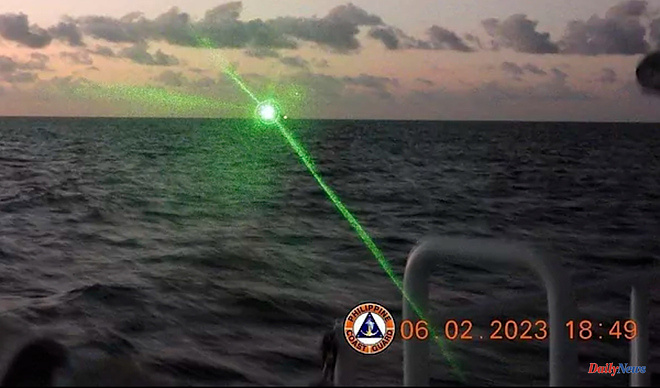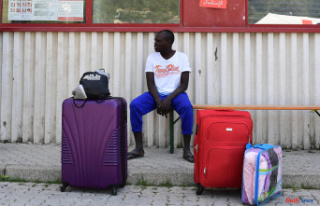As the world's two superpowers accuse each other of violating their skies by sending blimps with advanced surveillance equipment, China reportedly pointed a "military laser" at the Philippine military, with which the United States signed an expansion of its pact earlier this month. defense to allow US troops access to four more bases in this Southeast Asian country.
What the Philippines denounced a few hours ago was that the Chinese Coast Guard had used a laser to try to interrupt "a resupply mission for the troops" within its exclusive economic zone and very close to the Spratly Islands archipelago, which both China claims like the Philippines. In those same disputed waters, a couple of days ago there was evidence that the US Navy and Marine Corps were conducting joint exercises.
This Tuesday, the Philippine Foreign Ministry filed a diplomatic protest against Beijing. "Our vessel was assisting a mission to deliver food and supplies to troops on an atoll in the disputed waterway on February 6 when a Chinese Coast Guard boat directed a military-grade laser at the vessel, temporarily blinding his crew on the bridge," he told Philippine military spokesman Medel Aguilar.
After that appearance, from Washington, the State Department spokesman, Ned Price, wanted to make public his support for his allies: "In more general terms, the dangerous operational behavior of the People's Republic of China directly threatens regional peace and stability, infringes on the freedom of navigation in the South China Sea (also called the South China Sea) guaranteed by international law and undermines the rules-based international order."
For its part, the US Embassy in the Philippines has accused China of "provocative" and "dangerous" behavior. "China's attitude directly threatens regional peace and stability, infringes on the freedom of navigation in the South China Sea (...) and undermines the rules-based international order," denounced the US Embassy in the Philippines in a statement .
The US and the Philippines are signatories to the 2014 Enhanced Defense Cooperation Agreement (EDCA), which allows for joint military training and the provision of facilities such as airstrips, fuel storage and housing for soldiers from both houses, but not a presence permanent and immovable position of the troops of the first world power. The latest agreement signed two weeks ago in Manila by US Defense Secretary Lloyd Austin will facilitate greater surveillance of Beijing's movements in the disputed South China Sea, especially around Taiwan.
That deal, which was struck just before the first Chinese spy balloon came on the scene, shot down on February 4 by an F-22 jet off the coast of South Carolina, means the Philippines will now open the gates of four more bases. to the US military, which can already operate in a total of nine in the Southeast Asian country, located in a fundamental position in the event that Beijing attacks Taiwan and that the US decides to launch itself to defend the autonomous island that China considers a province separatist.
Until last year, controversial Rodrigo Duterte's Philippines had kept a certain distance from its longtime ally Washington, opposing closer military ties because it wanted to get closer to China. But since President Ferdinand Marcos Jr took office in June after winning elections, defense relations between the two countries have revived.
Manila, in exchange for letting US soldiers roam their bases, is asking for more funds to modernize its military, like the $100 million in funding the US recently approved. Also, the Philippine Department of National Defense said last week that Washington would allocate more than $82 million for infrastructure investments at the five previous bases it was given access to.
"This is an opportunity to increase our effectiveness, to increase interoperability," Austin said during his visit to Manila. "The United States and the Philippines remain committed to strengthening each other's capabilities to resist armed attacks. These efforts are especially important as the People's Republic of China continues to advance its illegitimate claims," he continued.
The Philippines and China have had quite a few run-ins over those "illegitimate claims" Austin was referring to. In Manila, they do not forget the water cannons that three Chinese coast guard ships launched at the end of 2021 at two Filipino boats that were transporting food to soldiers stationed at a low tide rise near the Spratly Islands.
Adding to that crisis, Philippine soldiers caught a glimpse of 300 Chinese maritime militia vessels patrolling around disputed islands. These apparently are dedicated to commercial fishing, but in reality they function as a paramilitary fleet that has been operating alongside the Chinese military for years to expand Beijing's political objectives in those key waters for trade routes and rich underwater oil and gas deposits. That situation calmed down when Washington reminded China that any armed attack against Philippine ships would force the US navy to intervene due to the mutual defense treaty that the United States has with the Philippines.
The Chinese government has never accepted the 2016 International Tribunal in The Hague ruling that the South China Sea is a shared maritime space where Beijing and Manila must cooperate both in its conservation and in its commercial exploitation.
According to the criteria of The Trust Project












